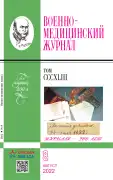Multimodal fluid replacement technique in burned patients
- Authors: Matveenko A.V.1, Tarasenko M.Y.1, Samarev A.V.1
-
Affiliations:
- The S.M.Kirov Military Medical Academy of the Ministry of Defense of the Russian Federation
- Issue: Vol 343, No 8 (2022)
- Pages: 28-34
- Section: Treatment and prophylactic issues
- URL: https://journals.eco-vector.com/0026-9050/article/view/629687
- DOI: https://doi.org/10.52424/00269050_2022_343_8_28
- ID: 629687
Cite item
Abstract
Volumetric fluid replacement is the cornerstone of burn resuscitation. The resuscitation strategy is to provide sufficient fluid to maintain organ function while avoiding the complications of over-resuscitation. There are dozens of formulas for calculating the predicted volume of fluid administered according to certain timing rules. The Parkland formula, which was most popular earlier, has now been abandoned. The formulas of recent years, as well as earlier ones, do not consider many factors that determine the patient’s response to trauma. The search for a solution to the problems of burn resuscitation is focused on ways to correct it and implement complex monitoring methods. A new multimodal fluid replacement technique is proposed, which is radically different from previous techniques, since it considers many risk factors.
About the authors
A. V. Matveenko
The S.M.Kirov Military Medical Academy of the Ministry of Defense of the Russian Federation
Author for correspondence.
Email: matveenko.45@list.ru
доцент, полковник медицинской службы в отставке
Russian Federation, St. PetersburgM. Yu. Tarasenko
The S.M.Kirov Military Medical Academy of the Ministry of Defense of the Russian Federation
Email: matveenko.45@list.ru
доцент, полковник медицинской службы запаса
Russian Federation, St. PetersburgA. V. Samarev
The S.M.Kirov Military Medical Academy of the Ministry of Defense of the Russian Federation
Email: al.samarev@yandex.ru
кандидат медицинских наук, подполковник медицинской службы
Russian Federation, St. PetersburgReferences
- Матвеенко А.В., Чмырёв И.В., Петрачков С.А. Определение тяжести состояния обожженных с помощью координатных сеток вероятности летального исхода // Скорая мед. помощь. – 2013. – Т. 14, № 1.– С. 34–43.
- Матвеенко А.В., Чмырёв И.В., Скворцов Ю.Р., Тарасенко М.Ю. О критериях тяжести ожоговой травмы // Воен.-мед. журн. – 2018. – Т. 339, № 3. – С. 21–26.
- Чмырёв И.В. Некрэктомия у обожженных: инновационные подхода при оказании специализированной медицинской помощи: Автореф. дис. ... д-ра мед. наук. – СПб, 2014. – 32 с.
- Allgower M., Shoenenberger G. A., Sparks B.G. Burning the largest immune organ // Burns. – 1995. – Vol. 21, Supp l.1. – S. 7–47.
- Bundgaard-Nielsen M., Sorensen H., Dalsgaard M. et al. Relationship between stroke volume, cardiac output and filling of the heart during tilt // Acta anaesthesiologica Scandinavica. – 2009. – Vol. 53, N 10. – P. 1324–1328.
- Chappell D., Jacob M., Hofmann-Kiefer K. et al. A rational approach to perioperative fluid management // Anesthesiology. – 2008. – Vol. 109, N 4. – P. 723–740.
- Chung K.K., Salinas J.P., Renz E.M. et al. Simple derivation of the initial fluid rate for the resuscitation of severly burned adult cobat casualties: In Silico Validation of the Rule of 10 // J. of Traum. Injury. – 2011. – Vol. 4, N 1. – P. 109–113.
- Fodor L., Fodor A., Ramon Y. et al. Controversies in fluid resuscitation for burnmanagement: literature review and our experience // Int. J. Care Injured. – 2006. – Vol. 37, N 5. – Р. 374–379.
- Greenhalgh D.G. Burn resustitation // J. Burn Care Res. – 2007. – Vol. 28, N 4. – P. 1–11.
- Holm C. Resuscitation in shock associated with burns. Tradition or evidence-based medicine? // Resuscitation. – 2000. – Vol. 44, N 3. – P. 157–164.
- Jones L.M., Coffey R.A., Bailey J.K. Resuscitation from Burn Shock: Back to the Future // Austin J. Emerg. Crit. Care Med. – 2015. – Vol. 2, N 6. – P. 1–5.
- Peeters Y., Lebeer M., Wise R., Malbrain M.L. An overview on fluid resuscitation and resuscitation endpoints in burns: Past, present and future. Part 2 – avoiding complications by using the right endpoints with a new personalized protocolized approach // Anaesthesiol. Intensive Ther. – 2015. – Vol. 47. – S. 15–26.
- Peeters Y., Vandervelden S., Wise R., Malbrain M.L. An overview on fluid resuscitation and resuscitation endpoints in burns: Past, present and future. Part 1 – historical background, resuscitation fluid and adjunctive treatment // Anaesthesiol. Intensive Ther. (Special issue). – 2015. – Vol. 47, N 5. – Р. 175–183.
- Pham T.N., Cancio L.C., Gibran N.S. American Burn Association Practice Guidelines Burn Shock Resuscitation // J. Burn Care Res.– 2008. – Vol. 29, N 1, – Р. 257–266.
- Saffle J.I. The phenomenon of «fluid creep» in acute burn resuscitation // J. Burn Care Res. – 2007. – Vol. 28, N 3. – P. 382–395.
Supplementary files






